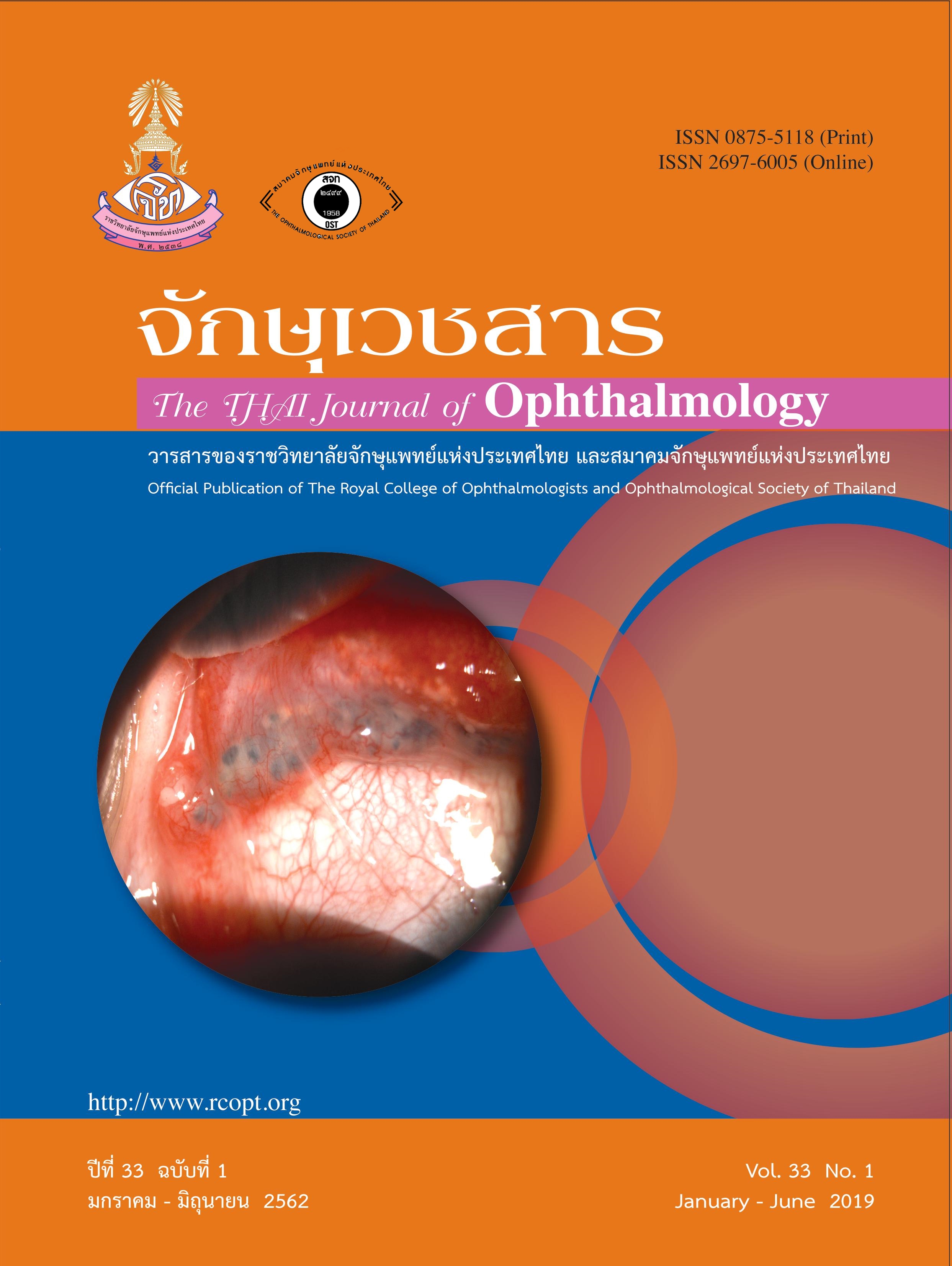Visual Outcome and Patient Satisfaction of Inferior Segmental Low Power Near Addition Intraocular Lenses (IOLs)
Keywords:
intraocular lens, inferior segmental low power near addition intraocular lensesAbstract
Purpose: To evaluate visual outcome and patient satisfaction following implantation of inferior segmental
low power near addition intraocular lenses (IOLs)
Setting: Department of Ophthalmology, Ramathibodi Hospital, Faculty of Medicine, Mahidol University.
Bangkok, Thailand.
Study design: Prospective longitudinal case series.
Methods: This prospective case series involved consecutive 123 eyes (87 patients) who underwent
phacoemulsification with implantation of inferior segmental low power near addition IOLs (LS313-MF15,
Oculentis GmbH, Berlin, Germany) at the Department of Ophthalmology, Ramathibodi Hospital. The adding
power is plus 1.5 diopters of intraocular lens is approximate plus 1.0 diopter of glasses. Visual outcome,
halo, glare, ocular optical quality, spectacle dependence and scores in a questionnaire were assessed at
least 3 months postoperatively.
Results: The study included 87 patients. Postoperative visual outcome of 85 patients (97.7%) was improved.
Satisfaction with near vision was 72.42% in the High and Good categories, 26.44% in the Moderate and
Minimal groups and 1.15% in the Dissatisfied group. Satisfaction with distance vision was 82.76% in the High
and Good categories, 14.94% in the Moderate and Minimal groups and 2.30% in the Dissatisfied category.
Satisfaction comparison between preoperative and postoperative vision of patients was found to be 87.36%
in the High and Good groups categories, 11.49% in the Moderate and Minimal groups and 1.15% in the
Dissatisfied group. Some patients (5.7%) need glasses for distance vision due to myopia and astigmatism
and 23% need reading glasses.More than 90% reported no or mild halos, glare, starbursts, or other photic
phenomena.
Conclusions:The inferior segmental low power near addition intraocular lenses (IOLs) restored distance,
intermediate and near vision after cataract surgery, with high levels of patient satisfaction and low levels
of disturbing photic phenomena.
References
Lang A, Portney V. Interpreting multifocal intraocular lens modulation transfer functions. J Cataract Refract Surg 1993;19:505–512
Buznego C, Trattler WB. Presbyopia-correcting intraocular lenses. Curr Opin Ophthalmol 2009; 20:13–18.
Alio JL, Pinero DP, Plaza-Puche AB, Chan MJ. Visual outcomes and optical performance of a monofocal intraocular lens and a new-generation multifocal intraocular lens; J Cataract Refract Surg 2011; 37:241–250.
Cochener B, Lafuma A, Khoshnood B, Courouve L, Berdeaux G. Comparison of outcomes with multifocal intraocular lenses: a meta-analysis. Clin Ophthalmol 2011; 5:45–56.
Woodward MA, Randleman JB, Stulting RD. Dissatisfaction after multifocal intraocular lens implantation. J Cataract Refract Surg 2009; 35:992–997.
de Vries NE, Webers CAB, Touwslager WRH, Bauer NJC, de Brabander J, Berendschot TT, Nuijts RMMA. Dissatisfaction after implantation of multifocal intraocular lenses. J Cataract Refract Surg 2011; 37:859–865.
McAlinden C, Moore JE. Multifocal intraocular lens with a surface-embedded near section: short-term clinical outcomes. J Cataract Refract Surg 2011; 37:441–445.
Cochener B; for the Concerto Study Group. Clinical outcomes of a new extended range of vision intraocular lens: International Multicenter Concerto Study J Cataract Refract Surg. 2016:42:1268-1275.
Kamiya K, Hayashi K, Shimizu K, Negishi K, Sato M, Bissen-Miyajima H, on behalf of the Survey Working Group of the Japanese Society of Cataract and Refractive Surgery. Multifocal intraocular lens explantation: a case series of 50 eyes. Am J Ophthalmol 2014; 158:215–220.
Downloads
Published
Issue
Section
License
The Thai Journal of Ophthalmology (TJO) is a peer-reviewed, scientific journal published biannually for the Royal College of Ophthalmologists of Thailand. The objectives of the journal is to provide up to date scientific knowledge in the field of ophthalmology, provide ophthalmologists with continuing education, promote cooperation, and sharing of opinion among readers.
The copyright of the published article belongs to the Thai Journal of Ophthalmology. However the content, ideas and the opinions in the article are from the author(s). The editorial board does not have to agree with the authors’ ideas and opinions.
The authors or readers may contact the editorial board via email at admin@rcopt.org.


